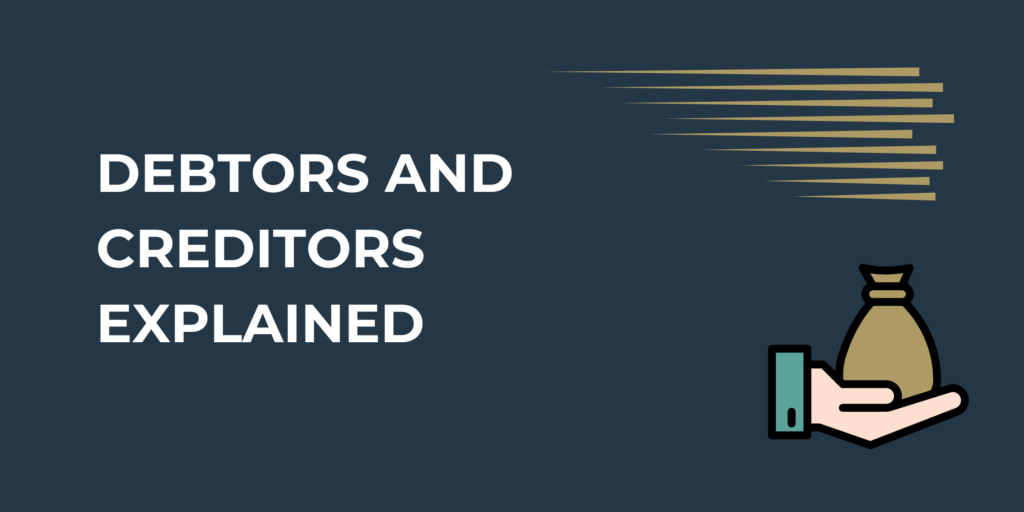Debtors and Creditors Explained: What is a Creditor or Debtor?

Whilst debtors and creditors may sound self-explanatory, it’s important that every business, however large or small, understands the role both play in their business.
In simple terms, debtors and creditors are who owes your business and who you owe.
The business world is based on credit; virtually every business relies on access to goods, services and finance before paying in full for them. As a result, there are debtors and creditors. To run a business properly, it is essential to be 100% clear about the meaning of the two terms.
Debtors
What is a trade debtor?
Trade debtors are customers and clients for whom you have provided goods or services without yet receiving payment. For example, where a client or a customer has received an invoice for goods and services, but this has not yet been paid. Reliable customers who pay on agreed timescales do not present a problem, but late payments can create serious problems. The larger the debt, the larger the potential problem.
What are other debtors?
Balance sheets will also feature an entry for ‘other debtors’. This is where businesses record payments due from organisations which are not customers – a repayment from HMRC, for example, or any loans made to other businesses.
What happens if you have a lot of debtors?
Whilst having debtors is a common occurrence within the business world, having a large number can pose its own challenges. For example, as you rely on your debtors paying on time, should a number of them not do so, it can cause issues with your cash flow and cause issues when it comes to meeting your own financial obligations.
As such, it is crucial that you closely monitor and manage debtor accounts to ensure that repayments are made within the agreed terms.
Managing your business’s debtors
There are several steps that businesses can take to manage their debtors:
- Have a clear credit policy in place
Just how you will have a policy in place with your creditors, you must have a clear and concise credit policy in place to outline the terms, and highlight the consequences of failing to make payments on-time.
- Run credit checks on debtors
When extending credit to debtors, you must always run a credit check. Knowing your customer’s credit history can help you to assess the risk involved and establish payment terms, based on the risks associated with that debtor.
- Work with professional debt collectors
If you are struggling to recover debts from customers and they are not responding to chases, you should consider hiring a professional debt collection service to work on your behalf. Whilst they do charge a fee for their services, it’s worth it if you can recover the money owed to your business.
Creditors
There are two main types of creditors: trade creditors and loan creditors. Trade creditors are suppliers who extend credit to customers in order to purchase goods or services. Loan creditors lend money in the form of a loan that must be repaid with interest.
What are trade creditors?
Trade creditors are suppliers which have provided your business with goods and services for which you have not yet paid. Trading terms agreed with the supplier will dictate when payment is due. Some businesses aim to create positive cash flow by having longer credit terms than debt terms.
What are other creditors?
Other creditors listed on a balance sheet covers sums due to other entities. This could include loans from directors, especially in small businesses, put in place to help cash flow.
What happens if you have a lot of creditors?
Whilst businesses can have a lot of creditors at any one time, it’s important to keep on top of these to avoid late payment charges and penalties, minimise the damage on your credit score, and ensure you don’t damage the relationship with the creditor.
Having a large number of creditors also means that you could be seen as high-risk, making it harder to get approved for credit in the future.
Managing your business’s creditors
Whilst having a number of creditors can be difficult to manage, there are ways to keep on top of your business’s creditors:
- Negotiate fair payment terms
When taking out credit, whether with a loan creditor or a trade creditor, it’s advisable that you negotiate fair payment terms with them, when entering into the agreement. An example of this would be setting out the amount of interest and the term of the agreement.
- Set up a system for tracking payments
The most effective way to manage creditors is to set up a system for tracking the payments. Depending on the size of your business, you can use simple calendar reminders, or leave it in the hands of your finance team who monitor payment due dates.
- Communicate with creditors
Should you be struggling to pay your creditors, the best thing to do is to communicate with them. You’ll often find they are willing to help, whether that be amending payment dates or re-negotiating terms.
- Prioritise high-interest rate creditors
If you are juggling multiple creditors, it can be worthwhile prioritising those with higher interest rates first. By doing this, you are not giving the interest rate time to grow, thus reducing the amount of money owed overall.
Debtors, creditors, and cash flow
As professional accountants, we advise our clients on maintaining accurate balance sheets and closely related cash flow statements. Balance sheets give a snapshot of the financial position of a business at a given moment in time. They are vital for good financial management, and are a key tool in managing the critical business discipline of maintaining a positive cash flow.
Cash flow dictates whether a business can pay salaries, rents, suppliers and other liabilities. Cash flow problems are often the final blow for many small businesses. In the words of digital accounting firm, Xero:
“Late payments and cash flow continue to be the primary financial challenges for small businesses. This year’s data revealed 24% experienced some degree of cash flow issues, and out of those, 72% have used personal funds to keep the business afloat. Despite these challenges, 92% have not applied for funding or loans in the past 12 months. Furthermore, 46% of respondents said they spend 1-2 months on average chasing late payments.” – Xero.com
The statistics underline the importance of managing debt and credit in their different forms. Key entries in a balance sheet are trade debtors and other debtors, as well as trade creditors and other creditors. Debtors are shown under ‘Accounts receivable’ as a current asset, and creditors come under ‘Accounts payable’ as a current liability.
Keeping on top of incomings and outgoings
Keeping on top of revenue coming into and expenses going out of a business is fundamental to running a successful business. That’s true for enterprises of every size, from startups to SMEs and large corporate companies.
Here are five tips based on our experience as professional accountants working with a range of small businesses, landlords, restaurants, charities, hotels, builders, sole traders, and other sectors:
- Follow a process for managing debtors and creditors, whether it is a simple set of steps to follow on basic software, or with a bespoke credit management system. If budgets allow, the process is made easier with a system which offers easy-to-view, real-time dashboards showing invoices, payment information by client and by supplier. Don’t hold back from sending reminders when payments are due or overdue.
- Produce clear payment terms specifying date due, within an agreed number of days of the date of the invoice. Consider discounts for early payments, interest charges for late payment.
- Use professionally-presented invoices detailing exactly the goods and services you have supplied. Make sure you send out invoices on time to head off excuses for late payment and to show that your business is professionally run.
- Enable straightforward methods of payment, with details of how to pay on each invoice. For single payments, online bank transfers are easy to use for payer and payee. For regular payments, consider direct debits or continuous credit card authority.
- Stay on good terms with suppliers and clients. Business relationships function well when there is underlying trust, respect and clear communication. Time spent on fostering open, respectful relationships is time well spent.
For a free consultation on how Perrys Accountants in London and Kent can help your business manage creditors and debtors, and the effects on cash flow and thrive, contact us now.








